- BY Nath Gbikpi

How to apply for “settled status” for EU citizens
THANKS FOR READING
Older content is locked

A great deal of time and effort goes into producing the information on Free Movement, become a member of Free Movement to get unlimited access to all articles, and much, much more
TAKE FREE MOVEMENT FURTHER
By becoming a member of Free Movement, you not only support the hard-work that goes into maintaining the website, but get access to premium features;
- Single login for personal use
- FREE downloads of Free Movement ebooks
- Access to all Free Movement blog content
- Access to all our online training materials
- Access to our busy forums
- Downloadable CPD certificates
See this article on applying for settled status after the deadline, which was on 30 June 2021.
Table of Contents
ToggleOn 31 January 2020 at 11pm, the United Kingdom left the European Union and entered a transition period, due to end on 31 December 2020. During this transition period, Europeans can continue to enjoy their freedom of movement rights in the UK as they did before Brexit.
That said, EU citizens and their family members who wish to remain living in the UK after 31 December 2020 will need to apply for an immigration status to remain legally resident. The Home Office has set up a special application scheme called the EU Settlement Scheme to process all the applications. EU citizens and their family members who can prove they have lived in the UK for five years or more will be granted settled status, and those living here for less than five years will be granted pre-settled status.
Applications can be very straightforward and simple but become more complex where the applicant has to submit additional documents to prove residence. We have put together this guide, which includes pictures of the various screens and a video walk-though, so that applicants know what to expect when they go through the process.
The scheme also covers citizens of Switzerland, Iceland, Norway, and Liechtenstein, but for convenience we’ll just talk about “EU citizens” in this article.
The basic terms of the Settlement Scheme are:
- EU citizens and any of their non-EU family members who arrived before 31 December 2020, and have been continuously resident in the UK for five years by the time of their application, will be eligible for settled status enabling them to stay indefinitely.
- EU citizens and their family members who arrive by 31 December 2020, but will not yet have been continuously resident here for five years by the time of their application, will be eligible for “pre-settled status”. This allows them to stay until they have reached the five-year threshold. They can then also apply for settled status.
- EU citizens and their family members with settled status or pre-settled status will have the same access as they currently do to healthcare, pensions and other benefits in the UK.
- Close family members (a spouse, civil partner, durable partner, dependent child or grandchild, and dependent parent or grandparent) living overseas will be able to join their EU citizen sponsor here after 31 December 2020, so long as the relationship existed on that date. Future children are also protected.
A vital feature of this arrangement for the 3.5 million or so EU citizens living in Britain is that they are not protected by it unless they make an online application to the Home Office. Failing to apply will mean that they end up with no legal right to live and work in this country. The Windrush generation can testify that being undocumented in “compliant environment” Britain is no fun at all.
While the deadline for applications is 30 June 2021, we would recommend everyone to apply by 31 December 2020, to ensure they can show they were living in the UK before that date.
The EU Settlement Scheme is underpinned by a set of administrative rules called “Appendix EU”. Appendix EU is where the detailed rules on the Settlement Scheme are found. It is not easy reading even for lawyers, though, so this post tries to explain what the rules are and how the scheme works in practice.
Overview
The Settlement Scheme involves an identity check and an online form.
The identity check can be done in several ways including:
- Using the “EU Exit: ID document check” app – this is available to EU nationals who have a biometric passport or ID and non-EU nationals who have a Biometric Residence Card issued to them under the EEA Regulations
- Attending a document scanner location (see more details below) – this is available to EU nationals who have a biometric passport and non-EU nationals who have a Biometric Residence Card issued to them under the EEA Regulations
- Sending the identity document to the Home Office by post – this is available to all but is most likely to be used by those who do not have access to the app or a document scanner location
- Attending an appointment at one of the Sopra Steria UK Visa and Citizenship Application Services (UKVCAS) – this is where non-EU nationals who do not have a valid Biometric Residence Card issued to them under the EEA Regulations will need to go
There is help available for people who can’t use the app or need help using the internet, which we’ll cover later on.
The ID checking app works on Android 6.0 and above, and now on iPhone 7 and newer models with iOS 13.2.
The system has been designed to be much easier than a typical immigration application. The existing application for “permanent residence” as an EU citizen notoriously involves an 85-page form and evidence of what the applicant has been doing in the UK. Settled status is largely based on proving residence in the UK and the application system has been streamlined. The system will check existing government databases for proof of residence, for example.
Most people should find the application reasonably easy, although people who are vulnerable in some way and/or have less evidence of their past residence in the UK — e.g. if they have never worked or claimed benefits — may struggle with the application and need help. Perhaps more worryingly, many applicants may end up agreeing to get pre-settled status when they are, in fact, eligible for settled status.
Failing to prove residence, or being rejected for having a criminal record (see below), means having no legal right to live in the UK. But the Home Secretary has said that “we will be looking to grant, not for reasons to refuse”. Of the millions of people who have applied to date, only a handful have been refused.
When should I apply?
Long story short: every EU national and their family will need to make an application before the deadline of 30 June 2021.
That said, I would add the following points:
- We do not yet know the immigration requirements that EU citizens who want to move here after 31 December 2020 will have to meet, but they are likely to be different from free movement. This means that, from 1 January 2021 onwards, there will be two “categories” of EU residents; those who arrived before the end of the transition period and those who arrived after. I would advise that those who arrived before transition should apply under the EU Settlement Scheme before 31 December 2020, to be able to distinguish themselves from the “new cohort” with employers, banks, the NHS, landlords and other bodies which have to verify immigration status before providing vital services.
- Non-EU family members of EU nationals whose current documents will expire before the deadline may also want to apply before the expiration of their current document. They may want to get a settled status document, rather than renewing their existing documents, to use for things like proving to employers, landlords and banks their right to live and work in the UK. Otherwise, family members will end up getting an old-style EU residence document and then having to switch onto settled status — they might as well go straight onto settled status.
- On the other hand, those who have not yet reached the five year residence mark but will by 30 June 2021 may want to wait until the five-year anniversary of their residence in the UK to apply. If not, they will be granted pre-settled status first, and will then need to make a second application for settled status once they have reached the five-year mark.
What will I need to prove?
I am an EU national
EU nationals will need to prove:
1. Identity and nationality
Applicants can provide evidence of their identity and nationality by uploading a passport or valid national identity card digitally via the smartphone app. This will only work if the passport or card is a biometric document with a chip (indicated by a rectangular gold symbol that looks like a camera).
Those who do not have a biometric document may send the documents by post instead. The identity document will be returned to the applicant “usually within three days of being received [by the Home Office]”, even before a decision has been made.
The Home Office may accept alternative evidence of identity where an applicant is unable to produce a passport or ID card “due to circumstances beyond their control or to compelling practical or compassionate reasons”.
Applicants also need to “enrol their facial image” (i.e. provide a photo of themselves).
2. Residence in the UK
Those applying for settled status need to show five years continuous residence in the UK. Those applying for pre-settled status need to show current residence in the UK.
Under Appendix EU, continuous residence simply means having lived, or living, in the UK. The definition of “qualifying period” at Annex 1 of Appendix EU makes no reference to “exercising Treaty Rights”. This means that EU nationals will not need to show that they have been working, studying or held Comprehensive Health Insurance (a big issue for many people refused permanent residence documents in the past).
In terms of evidence, the default position will be for the applicant to simply give their National Insurance Number. The Home Office will carry out automated checks of data held by Her Majesty’s Revenue and Customs (HMRC) and the Department for Work and Pensions (DWP). Those checks should show evidence of employment and receipt of benefits, which will indicate residence.
If the checks indicate that the applicant has been continuously resident in the UK for a period of five years, they will be granted settled status.
Of course, not everyone will have data with HMRC or DWP (for example, those who have never worked or received benefits).
In those cases, the applicant will then be able to upload documentary evidence of their continuous residence, still digitally. There is a useful list of documents which will count as evidence of residence at the end of the caseworker guidance. It confirms that:
This Annex provides non-exhaustive lists of the type of documentary evidence which the applicant will be able to provide. The guidance below is not prescriptive or definitive. Some applicants may lack documentary evidence in their own name for various reasons; you must work flexibly with applicants to help them evidence their continuous residence in the UK by the best means available to them.
I am the family member of an EU national
When lawyers talk about “family members” in this context, we mean non-EU citizens whose right to be in the UK depends on their family relationship with an EU citizen. If you are French and married to an Italian, you can both apply as we’ve described above. Whereas if you are Nigerian and married to an Italian, you can also apply under the Settlement Scheme, but the process will be slightly different.
You can find a detailed list of which family members are eligible for the scheme at Annex 2 of Appendix EU.
Family members of EU nationals may decide to apply for their new status at the same time as their EU citizen husband or mother or whoever it might be. The Home Office website encourages this, stating “You’ll probably get a decision more quickly if you apply at the same time as or after your family member.” Family members will need to prove, through the same documents as above, the EU national’s identity and residence in the UK, although “evidence of the EU citizen having been granted status under the scheme will be sufficient evidence of the person’s identity, nationality and continuous residence”.
In addition, they will need to submit evidence of
- Their own identity
- Their own residence in the UK
- Their relationship with the EU citizen
Non-EU nationals who do not have a biometric residence card will also need to enrol their biometric information (i.e. fingerprints and a photograph) by booking an appointment at a Sopra Steria centre.
What if I already have permanent residence or ILR?
Some EU citizens and their families may have what is called “permanent residence” — a technical legal term in this context — under EU law as it exists today and have a document to prove it. Similarly, EU citizens who have lived in the UK since before 2006 may have a document or stamp in their passport confirming “indefinite leave to remain” in the UK.
Those who have previously been issued a permanent residence document must still apply under the Settlement Scheme. Those who have indefinite leave to remain in the UK may apply, but do not have to. There are, though, advantages in applying for settled status for those who have indefinite leave to remain, including:
- Settled status lapses after an absence from the UK of five years, whilst indefinite leave to remain lapses after an absence of two years.
- The rules to have your family members join you in the UK are more generous for those who have settled status than those who have indefinite leave to remain.
- In the future, many bodies checking individuals’ immigration status, such as banks, landlords, the NHS etc may be more familiar with settled status documents than indefinite leave to remain. In addition, employers, for example, cannot accept an indefinite leave to remain stamp on an expired passport as evidence of right to work; EU nationals who have indefinite leave to remain are likely to have that stamp on an expired passport and will not be able to use that to prove their right to work when taking up a new job in the future.
Applicants who have a document certifying permanent residence or indefinite leave to remain will not have to provide further evidence of residence, but will be subject to criminality and security checks (see below).
The Home Office will, however, also need to confirm that their permanent residence status has not lapsed through absence of more than five consecutive years; or indefinite leave to remain has not lapsed through absence of more than two consecutive years. The applicant will simply need to “self-declare” that they have not been absent for that period of time. If the Home Office is satisfied “on the balance of probabilities”, that the applicant meets this requirement, they will be eligible for settled status. They may, to be satisfied of it, ask the applicant for evidence of that they have never been absent for more than those 2 or 5 years.
What about criminal records?
There will be criminality and security checks. Applicants will self-declare their criminal convictions (without having to submit evidence). In addition, though, the Home Office will carry out its own checks through the Police National Computer and the Warnings Index.
The government says that it will only refuse to grant settled or pre-settled status if you are “a serious or persistent criminal, a threat to national security, or have a deportation order, exclusion order, exclusion decision or removal decision against you”. This will not affect most people but there is more information in the official guidance.
Appendix EU also contains rules on refusal on the basis of “suitability”.
Rule EU15 sets out mandatory grounds of refusal:
- under EU15(a), an applicant must be refused if, at the date of decision, they are the subject of an extant deportation order or of a decision to make a deportation order
- under EU15(b), an applicant must be refused if, at the date of decision, they are the subject of an extant exclusion order or exclusion decision
In addition, under Rule EU16, caseworkers may (i.e. they do not have to, unlike Rule EU15) refuse an application. This can be done where “false or misleading information, representations or documents have been submitted (including false or misleading information submitted to any person to obtain a document used in support of the application)” that is “material to the decision”. EU16 can also be used to refuse settled status where the applicant is subject to a removal decision under the EEA Regulations.
Any decision made under Rule EU16 must be “proportionate”.
What if I am Irish?
Irish citizens will not be required to apply under the scheme (but “they may do so if they wish”). The intention is that nothing changes for them, in immigration terms, because of Brexit. Their family members who are not Irish or British will need to obtain status under the scheme, unless they have an independent right to live here under UK immigration law. They will be able to obtain settled status even if the Irish citizen does not apply for it.
How much does it cost?
It’s free.
What does the application look like in real life?
App
The first step is to download the EU Exit: ID Document Check app. This works on most modern Android smartphones and some iPhones.
The app will ask applicants for a phone number and email address. There are then four steps:
- Scan passport (or ID card)
- Put phone on passport
- Scan face
- Photograph face
Below are photographs of what shows up on the app during each of those four steps.
1.
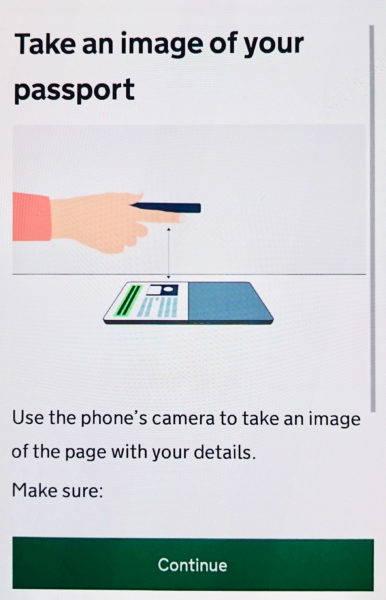
2.
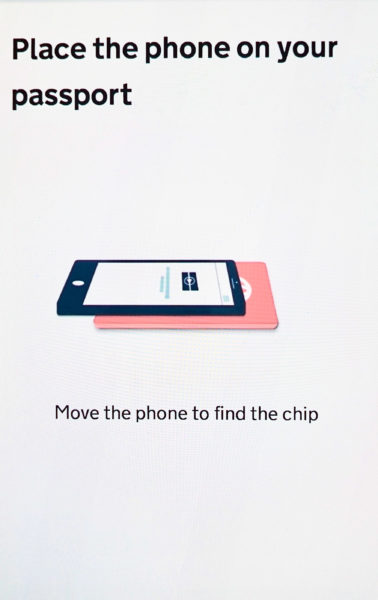
3.
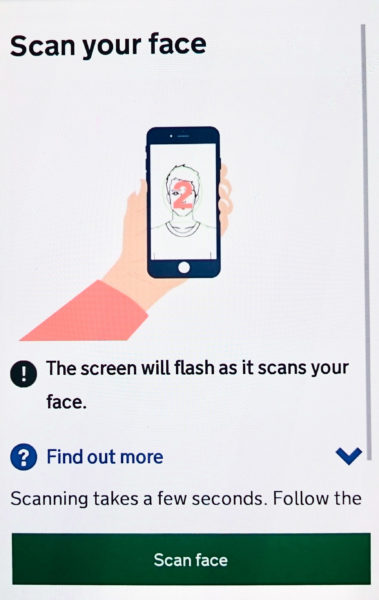
4.
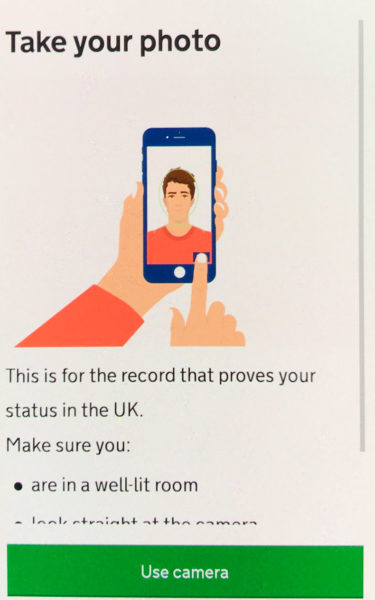
If you are using the app by going to an ID scanner location, you must attend the appointment before completing the online form. If you complete the online form before attending the appointment, you will have no choice but sending your identity document to the Home Office by post.
Online form
Once the applicant has entered their details in the app, they will be directed to a web page to continue the application. They will need to log in using some personal information and the phone number/email address given previously. They will then be sent an “access code” by email or by phone, which they will need to insert online to log in.
After logging in, the applicant sees a page that looks like this:
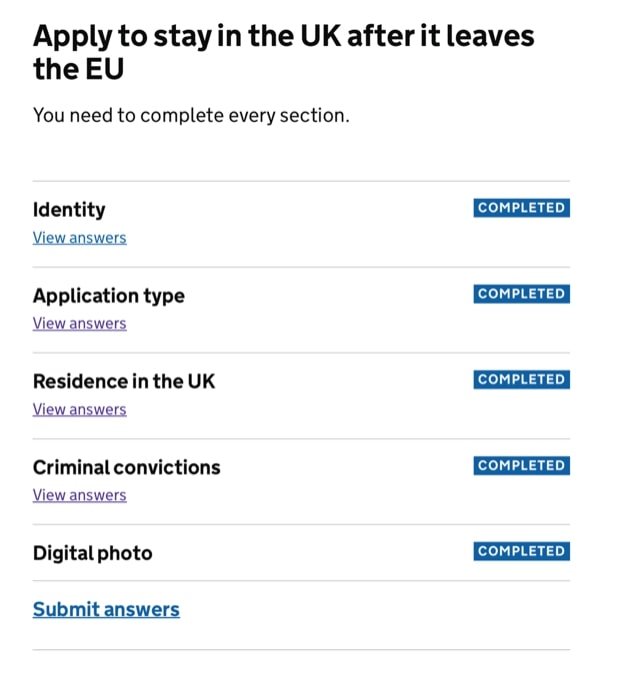
The “identity” and “digital photo” sections will show up as “completed” already, because that is done via the app. The applicant will need to fill in the sections on “application type”, “residence in the UK” and “criminal convictions”. For most people, this won’t take very long.
An important element of this part of the application is submitting a national insurance number, if the person has one. The Home Office will use this to automatically scan government databases to see if they have existing records of the person paying taxes or receiving benefits. If they exist, that will serve as proof of residence, so the applicant doesn’t have to submit their own evidence.

Declaration
Applicants will be then be asked to complete the declaration below:
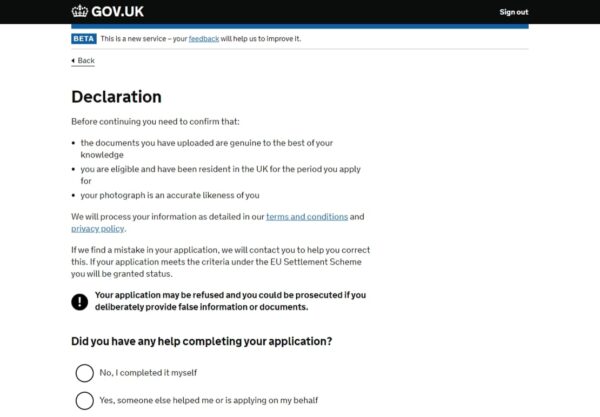
Consideration
The application process is not over once the applicant has answered these initial questions and submitted the declaration. The system will present applicants with one of three responses:
1. “You’ll be considered for settled status.”
This will show up if the automated scan of government data shows that the applicant has been living in the UK for a continuous five-year period. All that remains is for the application to go to a human decision-maker to sign off on the decision to grant settled status.
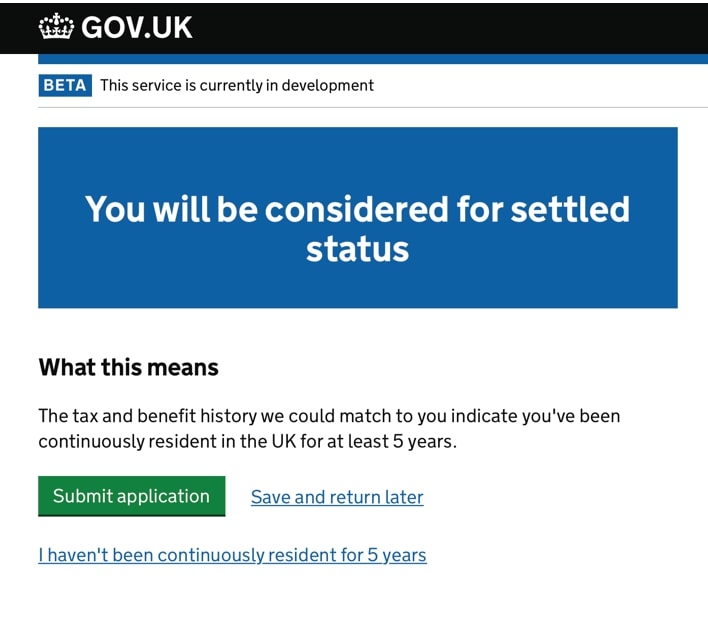
2. How long have you lived in the UK?
This will happen if the data does not show continuous residence for five years. The applicant is then given an opportunity to confirm whether they have lived in the UK for five years, in which case they are eligible for settled status; or for less than five years, in which case they are eligible for pre-settled status only.
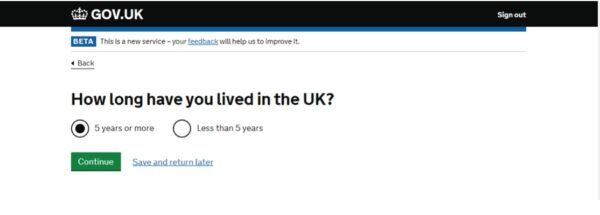
Whatever the applicant ticks, the website should then go on to tell them for which period they must submit evidence, if any. The Home Office needs evidence for at least six months for every year.
Scenario 1: Joao is a Portuguese national. He has lived in the UK since January 2015, but only started working in April 2018. He confirms that he has lived in the UK for more than five years. The Home Office should then ask him to submit evidence of his residence for the years 2015, 2016 and 2017 (they shouldn’t ask for 2018 because they should have HMRC evidence of his residence covering more than six months for that year).
Scenario 2: Joao has only lived in the UK since April 2018, and has worked throughout his time here. He confirms that he has lived in the UK for less than five years. The Home Office should have evidence of his residence in the UK and should simply grant pre-settled status, without asking for any further evidence.
Non-EU family members
Non-EU family members will, once they have completed the application form, be asked to upload evidence of their relationship to their EU national family member (for example a marriage certificate if they are married, or birth certificate if they are their children). This is uploaded online.
In addition, those who do not have a Biometric Residence Card issued to them as the family member of their EU national will be redirected to the Sopra Steria website to book an appointment. At the appointment, they will be showing their passports and enroling their biometric information (i.e. give their fingerprints and have a photograph taken).
Certificate of application
Applicants then receive a Certificate of Application. You can view an example here.
Decision
Once a decision has been made, applicants will receive a decision by email – example here.
This explains that their pre-settled or settled status in the UK can be confirmed online through the Home Office online checking service: ‘View and Prove your Rights in the UK’.
Applicants clicking that link will be asked to reconfirm the number of the document they used for the application (passport or biometric residence permit) and date of birth. They will then be asked to choose between their mobile number or email address (used during the application) where they will be sent a code. Once the code is inserted, they will get evidence of their status as shown below:
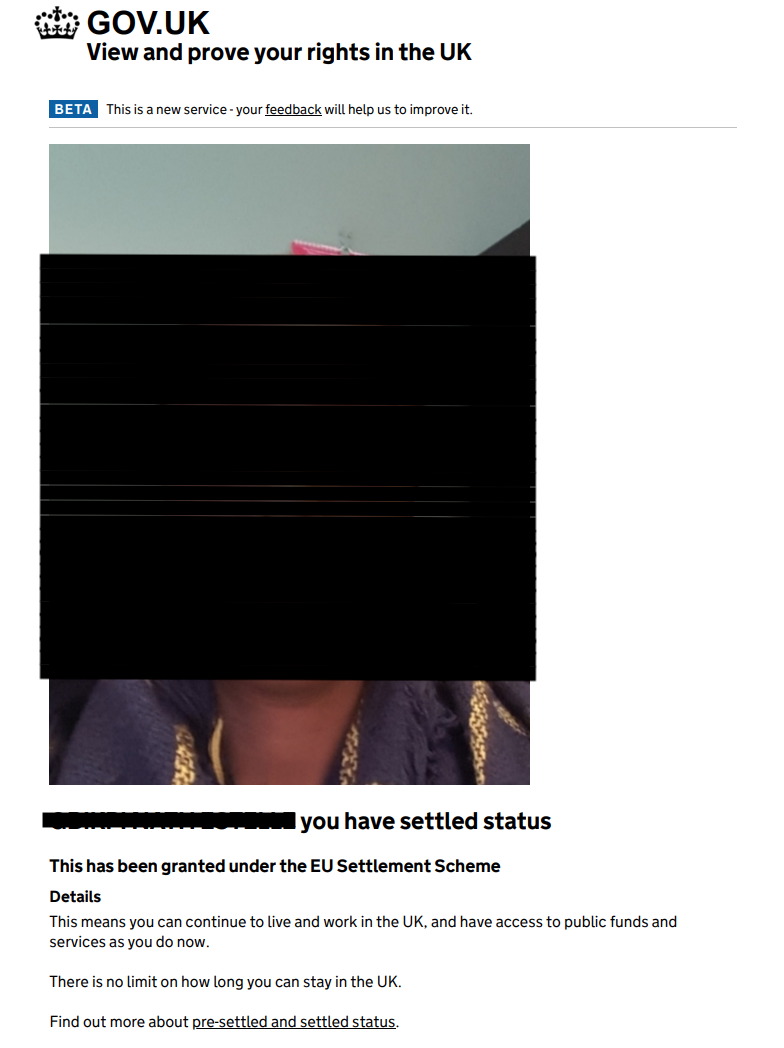
This is all that European nationals will get. Non-EU nationals who do not have a valid Biometric Residence Card will also be sent a Biometric Residence Permit confirming their status in the UK.
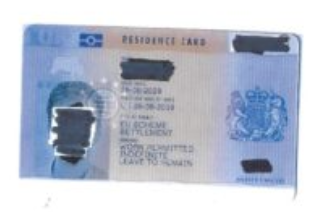
Video walk-through
We have recorded a screencast of a settled status application. It is embedded below. Some of details have changed since it was recorded, but the basic process is as depicted.
How long until I get a decision?
The Home Office publishes current estimated processing times on their website. Generally speaking, straightforward applications, for example where an applicant already has a document certifying permanent residence, can take as little as a couple of hours.
However, those who are asked to submit additional documents should expect to wait longer.
Can I get help with the application?
I do not have a phone which supports the app
You do not necessarily need to use the device linked to the mobile number provided in your application and it is possible to use the app on the same mobile for multiple applications. This means that you can borrow the phone of a friend, colleague or neighbour to use the app. In the alternative, you can make an appointment at one of the locations offering ID document scanning. The fee varies depending on the location, and is, in my experience, between £14 and £21. Note that these locations only accept European biometric passports (not national identity cards) and Biometric Residence Cards.
The other option is to send your identity document to the Home Office by post, who should return it to you within three days.
I do not know how to submit an application online
You can get advice online or face to face through the Assisted Digital service. However, you will need to have scanned your ID already. If you do not have an Android phone, you will first need to attend an appointment at one of the locations above, and then book an appointment for the Assisted Digital Service.
I have some other question
You can get help with your application on the phone or online by contacting the EU Settlement Resolution Centre:
Telephone: 0300 123 7379
From outside the UK: +44 (0)203 080 0010
Monday to Friday, 8am to 8pm
Saturday and Sunday, 9.30am to 4.30pm
Closed on bank holidays
Use the EU Settlement Scheme contact form to get help online.
What if my application is refused?
The first point to note is that, if an application is incomplete and a caseworker thinks that it can be easily rectified, they should contact applicants and give them a reasonable opportunity to submit supplementary evidence.
That said, if the application is refused, the remedy will depend on when the application was made. Those who applied before 31 January 2020 at 11pm will have a right to an administrative review, unless the refusal is made on “suitability grounds”, in which case it seems the only redress will be judicial review. Those applying for administrative reviews are, to put it simply, asking Home Office caseworkers to double check the decision. The rules relating to these administrative reviews can be found in Appendix AR (EU)of the Immigration Rules.
Those who apply after 11pm on 31 January 2020 will also have a statutory right of appeal. That is, they will be allowed to appear in front of an independent judge who will decide whether they should have been granted status. They can appeal both if they have been refused status altogether, or if they have been granted pre-settled status and believe they should have been granted the full settled status.
A person refused status under the scheme before 31 December 2020 may also make a further application under the scheme at any point before then.
Those who have been refused will be able to remain in the UK pending conclusion of the appeals process. That is unless, generally speaking, the application was refused “in the interests of national security” or a deportation order is made. That group might be removed before their appeal is heard, although they will be able to apply to return to the UK to attend their appeal hearing.
I have started an application for a document certifying permanent residence. Should I still apply or should I use the Settlement Scheme?
If you intend to apply for British citizenship, you might as well continue with your permanent residence application.
This is because you will need to show that you acquired permanent residence one year before the date of your application for British citizenship (unless you are the spouse of a British citizen, in which case you will simply need to show that you have permanent residence). If you apply under the EU Settlement Scheme, you will need to wait 12 months after being granted settled status to apply for British citizenship, irrespective of how long you have lived in the UK.
On the other hand, those who do not have a straightforward application for a document certifying permanent residence, for example because they have been students during the five-year qualifying period but did not have Comprehensive Sickness Insurance, would be well advised to apply for settled status, where they are no longer asked to show insurance.
This article was originally written in January 2018 and has been updated to take account of developments since.

21 responses
Very useful summary but I have a few minor comments after going through the Home Office document and one possibly more important.
Passport Style Photos
Section 4.10 refers to the need for a passport-style photo but it also says ” this should not be the same photo as that which appears in their passport. This difference should be made clear as otherwise quite a few applicants will simply use a copy of their passport photo.
Criminal Convictions
Section 5.17 says ” we are not concerned with minor offences such as a parking fine” Should this definition be clarified, eg are penalty points for speeding , considered a minor offence ?
Annex A – Preferred Evidence
If someone hasn’t worked in the UK but has an National Insurance number will that be accepted as evidence. If all household bills were addressed to one spouse/partner but paid from a joint account, what will be the situation ? Why can’t evidence of a UK driving licence issued by the DVLA in exchange for an EU country licence be accepted. Likewise could not being on the electoral register
(for 5 years or more ) which allow a EU national to vote in local elections be included as evidence of residency.
Section 7 – No physical document to be issued.
This possibly seems quite a drawback . I’m not a supporter of ID documents but surely this would be a useful document for EU nationals with settled status to carry. Obviously there would be a cost involved and producing a physical document would run the risk of a market in fraudulent documents.
Thank you for your useful comments. I have updated the post to reflect your point about passport-style photos, as I agree many applicants could get that wrong.
With regards to your comments on preferred evidence, I agree that there could be many alternative ways to show residence.; time will tell whether the Home Office will be as lenient as they say they will be and allow the evidence you suggest as proof of residence. Annex A is not meant to be definite or prescriptive so that an applicant would certainly be allowed to submit alternative evidence of residence when they do not have documents from the suggested list.
Finally, I agree that not having a physical document is a scary thought in a world where landlords, employers, banks and others are meant to check a person’s status, and may not be keen on having to run an electronic check themselves. This is all the more worrying knowing how many times the Employer Checking Service releases wrong information regarding the right to work of employees!
Dear Readers
I would be grateful for some clarity on the effects of those EU 27 not registered by 29 March 2019 when we leave EU which we are told is mandatory. Significant numbers could fall through the cracks will they then lose their rights ? Not doing so would render them unlawful or in Colin Yeo’s blog of 13 March 2017 could result in them committing a criminal offence .
Recently informed by my office that criminalsition is not factually correct as interpreted from Gov.UK website which appears to take a benign view of such inaction which seems a bit of a fudge. So which is it? are we to take a benevolent view that despite historical events like Operation Nexus and the Hostile environment principles all will be well ?. I am not comfortable with the obscurity its incumbent upon us to inform our clients of any risks in the process now branded EU Settlement Scheme.
Your views & opinions would be appreciated.
Derek Edwards
Citizens Advice Southend
Thank you for your comment. EU nationals must register by 30 June 2021, rather than 29 March 2019. The Home Office said that it “will exercise discretion if there are good reasons why someone has not been able to make an application before the June 2021 deadline”, but I agree it is unclear what will be the repercussions for those who do not apply, including criminal ones.
The Migration Observatory at the University of Oxford published an interesting report talking about the question of what happens if significant numbers of people fail to apply for “settled status” (http://migrationobservatory.ox.ac.uk/resources/reports/unsettled-status-which-eu-citizens-are-at-risk-of-failing-to-secure-their-rights-after-brexit/).
For the time being, I think we can only advise those who have not registered by 30 June 2021 as we currently advise any overstayers, i.e. that they might be liable to be detained and removed, that they have no right to work, drive and rent etc.
Hi,
I have a question about access to benefits for people with pre-settled status, both during the transition period and following it.
In the article you say that ‘EU citizens and their family members with settled status or pre-settled status will have the same access as they currently do to healthcare, pensions and other benefits in the UK’. Does this include welfare benefits (‘public funds’)?
If so, then those with settled status (ILR) will presumably have full access to public funds, but what about people with pre-settled status?
Currently although the NRPF restriction does not apply to EU nationals and their family members, their access to welfare benefits and social housing/homelessness assistance is determined by whether they have a right to reside as a qualified person and what type of right to reside they have. If the rights to access welfare benefits of non-settled EU nationals remain the same as they are now then the right to reside test will still need to be met, although there is no mention of it in Appendix EU!
Presuming no NRPF restriction will be attached to pre-settled status, will those with pre-settled status have full access to public funds, or will they still need to be the equivalent of a ‘qualified person’ under regulation 6?
Most of the EEA cases we deal with are around accessing welfare benefits and housing, so this is something I would love to have clarified!
Thank you so much,
Radha Ruskin
Bristol Citizens Advice
Dear Radha
That’s a very good and important question. Unfortunately, I don’t think we have a clear answer yet. The withdrawal agreement, if it is approved by the MPs, confirms that those European nationals who currently can access welfare benefits will continue to be able to do so after the UK leaves the EU. However you are right that in theory, that only covers those who are “qualified persons” (or those with settled status). I don’t think the government has made a clear statement as to whether those with “pre-settled status” who do not “exercise Treaty Rights” will be allowed to access welfare benefits, and I think it is fair to assume that they may very well not have access to those benefits, even though they will be allowed to remain living in the UK.
Thank you for this excellent and very helpful posting, written from experience. I had been trying to piece the story together from various parts of the gov.uk website. An extra letter seems to have crept into the text: the app is called “EU Exit: ID Document Check”
My wife already has PR status but she will need to go through this hurdle before the deadline. She has Apple smartphones, my Samsung J3 Galaxy has NFC (‘contactless’) but runs Android 5.1.1 so, as expected, it failed to load the app (which requires 6.0 or above) and displayed an ‘incompatible’ message. I note that the paperwork says that ‘you may use someone else’s phone’.
So we will need to beg, borrow, buy or hire a device if we wish to make an application before the full service begins. I assume that it need not actually be a phone (i.e. with SIM card) and that an Android tablet equipped with wi-fi or wired internet connection can be used with the app to capture ID information and submit it to the Home Office. But when you are ‘directed to a web page to continue the application’ is it then necessary to continue using the same device and app to make the online transaction and payment, or would it be possible to pick up the process on another smartphone or PC, not necessarily running the app or even Android, to complete the application? Then only the ID data might remain on the borrowed device, and it could be returned earlier if hired.
With more than three million potential applicants I imagine that enterprising mobile phone retailers, passport photographers and even market stall-holders might be offering ID data capture services while you wait, more conveniently than the listed providers. Would they require OISC registration, I wonder?
I shall trying asking these questions using the EU Settlement Scheme contact form.
Hi there,
Thanks for the feedback, delighted to know that the article is useful. I have also fixed the typo you point out.
In terms of your question about using one device to enter ID information on the app and another to fill in the form, yes absolutely that is possible. Do the app bit first and you can come back to the second stage at your leisure, on any device at all – it is just an online form so all you need is the internet. The link saying “continue application” on this page gets you to the login page: https://www.gov.uk/apply-stay-uk-leaves-eu-test-phase.
The Home Office has releases a list of locations where you can go to input ID information if you have no access to an Android phone – so hopefully there will be no need to do so on the black market, as it were…
CJ
Thank you, CJ, for this further information. I’ve now seen the embedded screencast – which will prepare us for the online questions, where I often find myself trapped by ‘silly’ problems of strict interpretation. Nath’s posting tells that “Those who have previously been issued a permanent residence document or have indefinite leave to remain in the UK will be able to exchange it for settled status …” and that “Straightforward applications, for example where an applicant already has a document certifying permanent residence, can take as little as one hour.”
My wife has a ‘vignette’ with the heading ‘RESIDENCE DOCUMENTATION’ and a number UKF xxxxxxx, dated 20 FEB 17, saying “Type of Document: Document Certifying Permanent Residence” stuck into a blue six-page card itself numbered Eyyyyyyy and headed “UK RESIDENCE DOCUMENTATION FOR A NATIONAL OF AN EEA STATE”. I assume that this is a PR Certificate, not a PR Card. A co-dated letter reported that PR was acquired 30 April 2006. She also has a 1975 passport with stamped imprint ‘Given leave to enter the UK for an indefinite period’.
Having now seen the screencast, it seems to me that she will have to answer ‘No’ (as instructed on the form) to the Question “Do you have a valid UK Permanent Residence Card?” [video timing 12:12] so she will lose the opportunity to give the details of her ‘document certifying permanent residence’. To the later question [video timing 13:47] “Have you ever been granted indefinite leave to remain (ILR)?” she can answer ‘Yes’ with the exact year. So it seems that she may not obviously immediately qualify to ‘exchange it’, even though she submitted full details of 145 periods outside the UK over more than 40 years when successfully applying for EEA(PR)!
While writing, I read elsewhere in FreeMovement reference to some problems with hyphenated names when using the app. My wife’s given name is Julie-Anne (example name, correct format) and this is exactly as printed on her valid EU passport. The character string at the foot of the passport page shows ..>JULIE>ANNE>>>.. and the Home Office Residence document, and their letter, refer to Julie Anne. I assume that it would be safer to refer to her as Julie Ann when making this further application to the Home Office. Has anyone any experience of this issue?
I somehow feel that these points would be better understood and responded to by those who actually make applications rather than the ‘EU Settlement Resolution Centre’. I’m planning to buy the cheapest suitable phone (SIM free) and have a go. I’d like to get it right first time. The information from FreeMovement is proving invaluable.
Dear Free Movement team and everyone else concerned with the issue,
I have been following the developments very closely since very beginning yet still keep failing to find an answer to the following question: what about close family members, who are EU nationals, coming to join EU nationals currently in the UK after 29 March 2022 in a no-deal scenario? This article says: “Close family members (a spouse, civil partner, durable partner, dependent child or grandchild, and dependent parent or grandparent) living overseas will still be able to join an EU citizen resident here until 29 March 2022. This is so long as the relationship existed on the date of Brexit. Future children are also protected.” Yet another article, published on the 6th of December by CJ refers to making it “harder for non-EU family members.”. Has it been clarified that the cut off date will also apply for future family members,joining EU nationals in the UK, who are EU nationals themselves, but will not be able to remain under skills-based immigration system?
If so, this sounds like a scenario of another disaster on quite a large scale waiting to happen: what if an EU citizen, with settled status, in the future wants to bring an elderly parent from the country of origin (EU) to the UK? An elderly parent will surely not qualify under skilled immigration scheme, and current Immigration Rules on adult dependent family members are practically impossible to meet. If that is the case, I imagine, that a lot of families settled in the UK will face a rather heartbreaking dilemma.
I understand that there probably is no clear answer to that, at least at the time being, but this is something that people are getting concerned about, so I was hoping maybe you will be able to comment.
Thank you for all the work you do.
Thank you for the very helpful article. In regards to the Decision Letter which confirms “Your settled status in the UK can be confirmed online through the Home Office online checking service: ‘View and Prove your Rights in the UK’: view-and-prove-your-rights.homeoffice.gov.uk. You may use the online service to show your settled status in the UK. **This letter is not proof of your status.**”
My question relates to “**This letter is not proof of your status.**”. How does a client evidence to their employer, landlord, agent, or in the event of sponsoring a family member to join them in the UK, that their status is, well, valid? Specifically, evidencing a sponsor’s immigration status for entry clearance. Many thanks, Lesley.